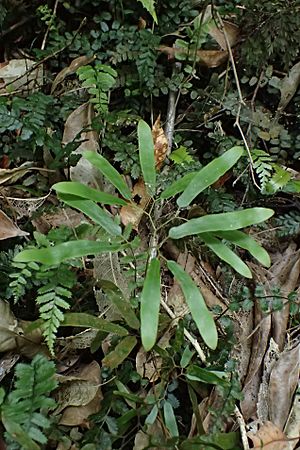Lygodium articulatum facts for kids
Quick facts for kids Lygodium articulatum |
|
|---|---|
 |
|
| Scientific classification | |
| Genus: |
Lygodium
|
| Species: |
articulatum
|
Mangemange (pronounced mah-ngay-mah-ngay), also known as Lygodium articulatum, is a special type of fern. It's often called "Bushman's mattress" because of how springy it is! This fern is found only in the forests of New Zealand's North Island.
What makes mangemange unique is how it grows. It creates a thick, vine-like curtain high up in the forest canopy. Even though most of the plant is up in the trees, its roots and main stem grow on the ground. This means it's not an epiphyte, which is a plant that grows entirely on another plant.
What Does Mangemange Look Like?
The mangemange fern has roots that spread out sideways from its main stem, called a rhizome. These rhizomes are long, hairy, and creep along the ground. From these rhizomes, the fern's leaves, called fronds, grow out with space between them.
These fronds twist and climb, looking for nearby branches or trees to hold onto. Once the plant finds support, it grows two types of smaller leaves, called pinnae:
- Sterile pinnae: These are flat and smooth. They are about 10 centimeters (4 inches) long. Their job is to make food for the plant using sunlight.
- Fertile pinnae: These are smaller, about 1 centimeter (0.4 inches) long, and look wrinkled or fan-shaped. They have special structures that hold tiny yellow spores. When these spores are ready, they turn into a fine dust that helps the fern reproduce.
Mangemange can grow very quickly, sometimes reaching 3 meters (10 feet) high into a tree. It can form a thick wall or curtain of leaves and tough, twiggy vines. Because its rhizomes are so strong, it can sometimes be hard to walk through areas where it grows thickly.
Where Does Mangemange Grow?
You can find mangemange mostly on the North Island of New Zealand. It grows in regions like Northland, Auckland, the Volcanic Plateau, Gisborne, and Taranaki. It can grow from sea level all the way up to 950 meters (about 3,100 feet) high on mountains.
Since mangemange is a climbing fern, it needs other plants to grow on. It often grows in areas with mānuka and kānuka scrub. You can also find it in forests with large trees like kauri and podocarp trees, as well as other broadleaved forests.
How People Used Mangemange
The name "Bushman's mattress" comes from how springy the vines and stems of mangemange are. The Māori, who are the native people of New Zealand, used these springy vines to make comfortable beds. They would coil the vines and put them into sacks, then stuff the sacks with soft plants.
Māori also used the strong, wiry stems of mangemange for many other things. They made items like:
- Fishhooks
- Rope
- Thatching for roofs
- Traps for catching eels
The leaves and fronds of mangemange were also used in traditional medicine. People would soak them in water and drink the liquid to help with stomach aches and pains. When the leaves were dried, they gave off a nice smell and were sometimes even used as a type of diaper.

